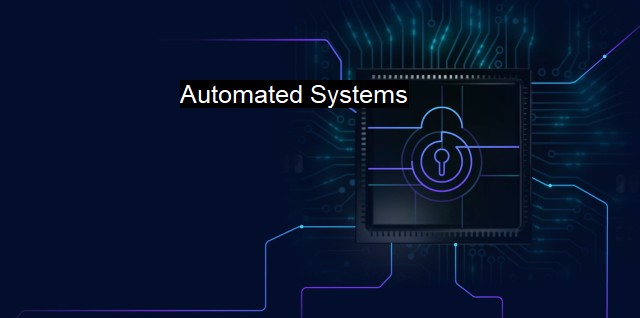What are Automated Systems?
The Rise of Automation in Cybersecurity and Antivirus: Exploring the Significance of Automated Systems
"Automated Systems" refer to a set of processes or protocols that are operated and controlled using computer systems and machines, without the need for human intervention. The primary goal of automation in this sense is, to ensure that data protection measures are consistently implemented, prevent human errors, enhance efficiency, reduce vulnerabilities and improve the overall security posture of an entity.Automated cybersecurity systems are fascinating tools that use algorithms, artificial intelligence, and machine learning to detect potential security threats and implement countermeasures automatically. These systems can analyze vast amounts of data, unravel hidden patterns that might indicate a potential breach, and deploy remedial actions in real-time, thereby offering a proactive shield against potential cybersecurity attacks.
An antivirus is a fine example of an automated system in cybersecurity. Such software automatically scans your computer for known malware, detecting and eliminating threats before they can disrupt your system or compromise your data. Modern antivirus software is powered by sophisticated AI algorithms that can even detect previously unknown threats, thereby providing comprehensive protection.
Adding further, these automated systems in the parasite of cybersecurity prevent data breaches, safeguarding sensitive information from unknown threats. Once a threat gets flagged, they assess the level of risk associated with such distress and take requisite action without any lags. This rapid re-active gesture makes cybersecurity efficient while emphasizing human potentials on strategic functions.
Automated systems can also be useful in patch management. Patching is a time-consuming, but crucial exercise that involves updating software applications to rectify any potential vulnerabilities. it is virtually impossible to manually patch every software application, considering the sheer number involved. Automated systems solve this problem by routinely monitoring, testing, and then applying patches as they become available, thus keeping all systems updated and secured at all times.
Other applications of automated systems within the cybersecurity realm include threat hunting and incident response. These tasks entail detecting, isolating, and neutralizing cyber threats based on predefined criteria and protocols. With automated systems, businesses can respond to cyber threats in real-time, reducing the potential damage of these threats, and ensuring operational continuity.
One potential pitfall of automated systems is that, despite their efficiency, they're not perfect, and there will always be reasons to keep human intervention. For one, cyber threats are continually evolving. Hackers are notorious for finding new ways to bypass security measures, and a system built to detect and respond to known threats might not be equipped to handle a novel type of attack. machines lack reasoning ability. Humans are needed to make nuanced decisions when dealing with complicated and sophisticated threats.
Automated systems utilize cutting-edge technology such as AI and Machine Learning to proactively identify, analyze, respond, and neutralize potential cyber threats. They continuously work in the background, regularly scanning systems for vulnerabilities and deploying the necessary defenses to protect a network and its data from any damage. While these systems can greatly improve the speed and efficiency of your cybersecurity infrastructure, human input remains crucial for dealing situations that automation systems may overlook. Hence, striking a balance between automation and human intervention is pivotal to achieving and maintaining a robust cybersecurity system.
Automated systems have assumed a central role raising security standards significantly. Cybersecurity has indeed embarked on an automation journey, a transformative journey that leverages automation to streamline and simplify the security process, and make it more effective in fighting cyber-adversaries while still retaining that all-too-critical human touch.

Automated Systems FAQs
What is an automated system in cybersecurity?
An automated system in cybersecurity is a software or tool that is designed to perform certain tasks automatically without the need for human intervention.What are the benefits of using automated systems for antivirus?
Using automated systems for antivirus provides several benefits, including faster and more efficient detection and removal of threats, reduced need for human intervention and oversight, and increased accuracy and consistency in threat identification.What are some common examples of automated systems used in cybersecurity?
Some common examples of automated systems used in cybersecurity include intrusion detection and prevention systems, anti-virus and anti-malware software, and security information and event management (SIEM) systems.How can businesses ensure that their automated systems are effective at preventing cyber attacks?
To ensure that their automated systems are effective at preventing cyber attacks, businesses should regularly update and maintain their software and tools, regularly test their systems and processes for vulnerabilities, and incorporate threat intelligence and analysis into their security strategies. Additionally, businesses should work with cybersecurity experts and consult industry best practices to stay up-to-date on the latest threats and trends in the cybersecurity landscape.| | A | | | B | | | C | | | D | | | E | | | F | | | G | | | H | | | I | | | J | | | K | | | L | | | M | |
| | N | | | O | | | P | | | Q | | | R | | | S | | | T | | | U | | | V | | | W | | | X | | | Y | | | Z | |
| | 1 | | | 2 | | | 3 | | | 4 | | | 7 | | | 8 | | |||||||